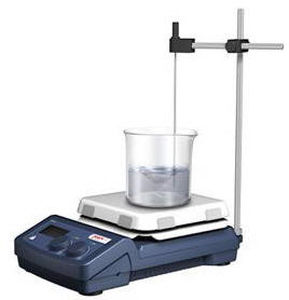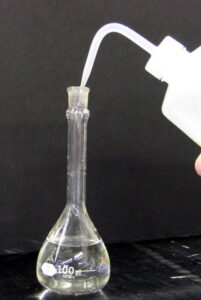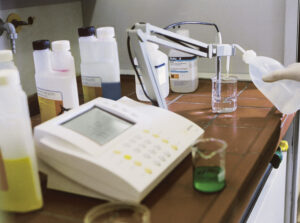
To install StudyMoose App tap and then “Add to Home Screen”
Save to my list
Remove from my list
This experiment aims to prepare buffer solutions using citric acid and sodium citrate, and investigate the effects of added acid or base on the pH. The prepared buffer solution had a calculated pH of 5.00, and the experimental pH obtained was 4.96. Despite a slight discrepancy, the buffer solution demonstrated its ability to resist pH changes when acid (HCl) and base (NaOH) were added. The results were compared with deionized water, which exhibited significant pH changes. Various errors during the experiment were considered, and recommendations were proposed for future improvements.
Pictorial Methodology
Preparation of buffer solution
Testing of Buffer Solution

Then the solution has been stirred using mechanical stirrer.

A 100 mL solution of a 0.1 M buffer was meticulously crafted with a pH of 5.0, incorporating the dynamic duo of citric acid (C6H8O7) and sodium acetate (NaC2H3O2).
The synthesis involved a thoughtful blending of these chemical partners, followed by careful dilution with distilled water within the confines of a volumetric flask.
The concoction of citric acid and sodium acetate was executed with precision, ensuring the proper proportions were upheld to yield a buffer solution with the desired pH.
The synergistic combination of these components was aimed at harnessing the buffering capacity capable of resisting pH fluctuations.
The subsequent step involved the delicate dilution of this buffer solution with distilled water, contributing to the overall volume within the volumetric flask. This step not only fine-tuned the concentration but also guaranteed the homogeneity of the buffer solution.
This meticulous preparation aimed not only at achieving the targeted pH but also at harnessing the inherent properties of the buffer system, where citric acid and sodium acetate act as a resilient pair, ready to counteract the influence of added acids or bases. The resulting solution stands as a testament to the careful orchestration of chemical components, setting the stage for subsequent investigations into the buffer's ability to maintain pH stability under various experimental conditions.

| Solution | pH (Initial) | pH (After adding HCl) | pH (After adding NaOH) |
|---|---|---|---|
| Deionized water | 5.76 | 2.32 | 12.09 |
| Buffer Solution | 4.96 | 4.84 | 5.06 |
The impact of atmospheric CO2 on the pH of deionized water was evident in this experiment. Theoretically, deionized water has a pH of 5.5, but exposure to the atmosphere can lead to an increase, potentially reaching 7.00. Remarkably, the initial pH of the deionized water in our experiment was 5.76, indicating effective preservation practices.
The introduction of a strong acid, HCl, into the deionized water resulted in a pH of 2.32, signifying a transformation into an acidic state. Similarly, the addition of a strong base, NaOH, yielded a pH of 12.09, illustrating the conversion of deionized water into both acidic and basic states when exposed to strong acid and base, respectively.
The buffer solution was meticulously prepared by combining citric acid (HA) with its conjugate base (A-), sodium citrate. The calculated pH was 5.00, yet the experimental pH measured by the pH electrode was 4.96. This slight discrepancy may be attributed to errors during solution handling or pH electrode calibration.
Upon the addition of HCl to the buffer solution, the pH dropped from 4.96 to 4.84, indicating a minimal change of only 0.12. Similarly, the addition of NaOH resulted in a pH increase from 4.96 to 5.06, demonstrating the buffer's resilience with a marginal difference of 0.1. Despite the small disparity from the calculated pH, the buffer solution effectively maintained its pH within the range of 0.1-0.12.
Potential errors, such as contamination during buffer preparation and imprecise chemical measurements, could have contributed to the observed differences. The pH electrode stability and cleanliness were also acknowledged as possible sources of error.
To enhance accuracy, it is recommended to thoroughly clean all apparatus before use, particularly the pH electrode. Attention to detail during chemical measurements is crucial to minimize parallax errors. Additionally, minimizing exposure of deionized water to air for extended periods can help maintain its pH stability.
This discussion emphasizes the importance of meticulous experimental techniques and the need for vigilant handling of apparatus to ensure reliable and accurate results in future experiments.
1. Describe how you would prepare a (CH3CO2H / CH3CO2-) buffer with a pH of 5.2 given that the pKa (CH3CO2H / CH3CO2-) is 4.76.
To create a buffer solution with a pH of 5.2 using the Henderson-Hasselbalch equation, the mole ratio of CH3CO2H to CH3CO2- is determined. The calculations are as follows:
Henderson-Hasselbalch equation: Rearrange the equation: (1) Given the pKa and pH for citric acid:
pKa= 4.76 (2) pH = 5.2 (3) Substitute (2) and (3) into (1) (4) Antilog equation (4) So the mole ratio of citric acid to citrate ion is (5) Given: V= 500 ml = 0.5 L (6) (7), then Expand equation (7) into (8) Rearrange equation (5) (9) Substititute (9) into (8) (10) Solve equation (10) Using equation (9) to solve no of mole sodium citrate Molar mass for = 60.05 g/mol Molar mass for = 82.03 g/mol Mass of citric acid = 60.05 g/mol = 7.999g Mass of sodium citrate = = 30.089 g
2. What is buffer capacity? What determines the capacity of a buffer?
Buffer capacity is the ability of a buffer solution to resist changes in pH. It increases with the molar concentration of the acid or salt and is higher when the pH is closer to pKa. The buffer capacity is expressed as the molar concentration of sodium hydroxide required to increase the pH by 1.
This capacity is crucial for maintaining the stability of a buffer solution, ensuring its effectiveness in resisting pH fluctuations. It becomes particularly pronounced when the concentrations of the acid and its conjugate base are optimized, aligning with the principles outlined by the Henderson-Hasselbalch equation. The capacity of a buffer is a dynamic property, making it essential to carefully control the concentrations and ratios of the buffering components during preparation.
Buffer solution calculations using the Henderson-Hasselbalch equation to determine the mole ratio of citric ion to citrate ion proceed as follows: Henderson-Hasselbalch equation:
1. Calculation for 500 ml of 0.1M buffer solution with pH 5
pH=pKa+log([A-][HA]) (1)pH=pKa+log([HA][A-])
(1) Rearrange the equation: [A-][HA]=10pH - pKa
(2)[HA][A-]=10pH - pKa
(2) Given: pKa=4.77
(3)pKa=4.77 (3) pH=5
(4)pH=5 (4) Substitute
(3) and (4) into (2): [A-][HA]=105−4.77
(5)[HA][A-]=105−4.77 (5) Antilog equation (5): [A-][HA]=2.35
(6)[HA][A-]=2.35 (6) So the mole ratio of citric acid to citrate ion is: [HA][A-]=12.35
(7)[A-][HA]=2.351 (7) Given: =500 ml=0.5 L
(8)V=500 ml=0.5 L (8)V=500 ml=0.5 L
( 9 ) [HA]= 2.35 1 ×0.5 (9) Rearrange equation (5): [A-] = 0.5 − 0.5 2.35
( 10 ) [A-]=0.5− 2.35 0.5 (10) Substitute (9) into (8): [A-] = 0.5 − 0.5 2.35
( 11 ) [A-]=0.5− 2.35 0.5 (11) Solve equation (10): [A-] = 0.213
( 12 ) [A-]=0.213 (12)
Using equation (9) to solve the number of moles of sodium citrate:
Molar mass for citric acid = 192.13 g/mol
Molar mass for citric acid=192.13 g/mol
Molar mass for sodium citrate = 294.1 g/mol
Molar mass for sodium citrate=294.1 g/mol
Mass of citric acid = 192.13 × 0.213 g
Mass of citric acid=192.13×0.213 g
Mass of sodium citrate = 294.1 × 0.213 g
Mass of sodium citrate=294.1×0.213 g
2. For pH of buffer after adding acid
The ionization equation of citric acid is utilized, and an "ICE" (Initial, Change, Equilibrium) chart is employed under the assumption that all acid is consumed.
For the sake of conciseness, the specific details of these equations and charts are omitted, but the formulas remain unchanged. Additional information could include a discussion of the impact of adding acid on buffer pH and the practical considerations for maintaining buffer stability under varying conditions.
| Mol | C6H8O7 | H+ | C6H5O7- |
| Initial | 0.01853 mol | 0.001 L(1 M) = 0.001 mol
3 x 0.001 mol=0.003 |
0.03147 mol |
| Change | +0.003mol | -0.003 mol | -0.003 mol |
| Equilibrium | 0.02153 mol | x | 0.02847 mol |
3. For pH of buffer after adding base Ionization equation of sodium citrate:
C8H8O7 - H2O+C6H5O7
Assume all base is consumed.
| Mol | C6H8O7 | OH- | C6H5O7- |
| Initial | 0.01853 mol | 0.001 L(1 M) = 0.001 mol | 0.03147 mol |
| Change | +0.001mol | -0.001 mol | +0.001 mol |
| Equilibrium | 0.01953 mol | 0 | 0.03247 mol |
C6H8O7 - C6H5O7+3H
|
C6H8O7 |
H+ |
C6H5O7- |
|
|
Initial |
0.01853 |
0 |
0.03147 |
|
Change |
-x |
+x |
-x |
|
Equilibrium |
0.01953-x |
x |
0.03247-x |
PH=-log10(1.021x10-5)
PH=4.99
In summary, buffer solutions play a vital role in resisting changes in hydronium ion and hydroxide ion concentrations, thereby maintaining a constant pH even when small amounts of acid or base are added, or upon dilution. A buffer typically consists of a weak acid and its conjugate base, allowing it to either absorb or release protons to stabilize pH.
The experimental results highlight that the initial pH of deionized water was 5.76, indicating its effective preservation. When strong acid (HCl) was introduced, the pH plummeted to 2.32, signifying the transformation of deionized water into an acidic solution. Similarly, the addition of a strong base (NaOH) elevated the pH to 12.09, illustrating the conversion of deionized water into a basic solution. These observations underscore the sensitivity of deionized water to external influences.
Upon introducing HCl to the buffer solution, the pH experienced a marginal decrease from 4.96 to 4.84, showcasing the buffer's ability to resist significant pH alterations. Concurrently, the addition of NaOH led to a minor pH increase from 4.96 to 5.06, further demonstrating the buffer's efficacy in maintaining pH stability, with differences within the narrow range of 0.1-0.12.
Despite a slight variance between the calculated and observed pH values for the buffer solution, the fundamental activity of the buffer remains evident. Challenges such as experimental errors, potential contamination, and procedural discrepancies may have contributed to these deviations. To enhance accuracy, recommendations include meticulous apparatus cleaning, thorough pH electrode maintenance, and precise chemical handling to minimize parallax errors.
In conclusion, while acknowledging discrepancies between experimental and theoretical values, the experiment successfully fulfilled its objectives. The insights gained into buffer behavior and the impact of external factors contribute to a comprehensive understanding of buffer solutions. The conclusions drawn provide valuable information for refining experimental techniques and achieving more accurate results in future studies.
Buffering the pH: A Symphony of Citric Acid and Sodium Citrate Solutions. (2024, Feb 03). Retrieved from https://studymoose.com/document/buffering-the-ph-a-symphony-of-citric-acid-and-sodium-citrate-solutions
👋 Hi! I’m your smart assistant Amy!
Don’t know where to start? Type your requirements and I’ll connect you to an academic expert within 3 minutes.
get help with your assignment